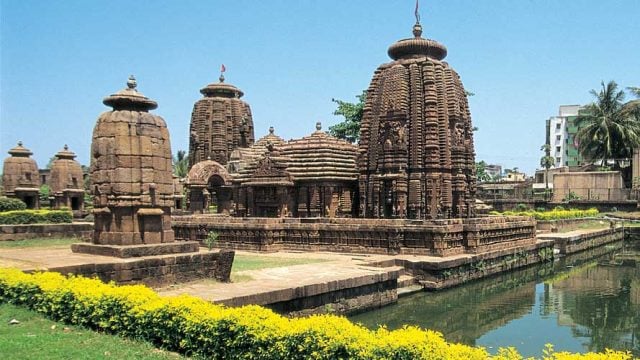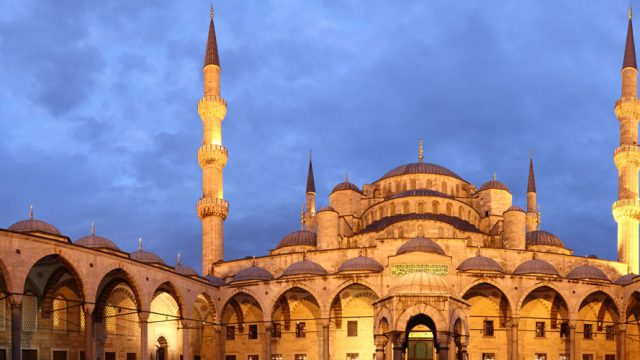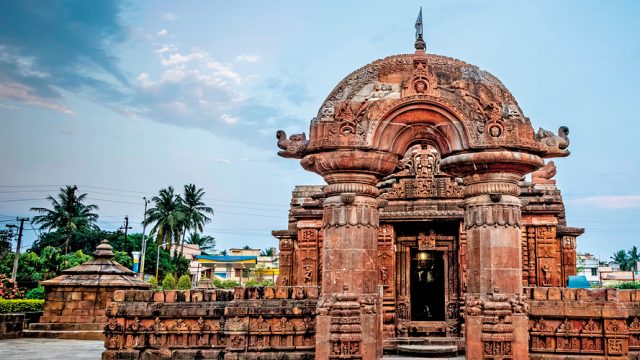From atop the Dhauli Hill, the highest point in the region around Bhubaneswar, the view is picturesque—
Bhubaneswar is generally considered a Hindu city, the ‘Kashi of the East’. While everyone has heard of Ashoka, not many know that it was here that Buddhism flourished for close to 1,000 years. What is even lesser known is that in the first century CE, a Jain monarch Kharavela of the Chedi dynasty ruled here. And that the 7th century CE produced temples of such breathtaking beauty and grace, that Bhubaneswar blossomed into the multicultural city we know today.
The Bhubaneswar of today, however, singularly lacks the aesthetics, sensibilities and ethos of its previous avatar. The modern capital of Odisha has been developed by engineers and architects with a clearly utilitarian ethic, and hence appears soulless. So, if you are looking for cultural pursuits other than admiring temples and caves, be forewarned.
Things to See & Do

Legend has it that there were originally 7,000 temples in the city, built over 700 years. Only 600 have survived the ravages of time and iconoclasts. They can be divided into three loose clusters that can be explored on foot. Excavations of three monasteries at Ratnagiri, Udayagiri and Lalitgiri, about100 km from the capital Bhubaneswar, bear witness to Buddhism’s fruitful tryst with this region until well into the13th century. Jain Emperor Kharavela’s artistic accomplishments can be glimpsed at the impressive Udayagiri and Khandagiri caves, about 6 km from the capital.
The Raja Rani Temple Cluster
The early 11th-century Raja Rani Temple stands in splendid isolation amid well-manicured lawns. No one offers prayers here any more. The richly illustrated themes from Shiva and Parvati’s lives suggest it may have been a Shaivite temple. Incidentally, the name of the temple has nothing to with any king or queen; it refers to a type of sandstone locally called rajaraniya.
The carvings, wonderfully baroque and indulgently sensuous, are stunning. Many might consider the erotica on the walls pornographic but as one temple connoisseur explains, “There is an aura of beauty and sanctity that envelops everything, even the seemingly ignoble, and the so-called obscene.”
Entry fee Indians ₹ 5, foreigners ₹250 Timings 8 am-6 pm, open all days Cameras Still free, video ₹ 25. With the exception of the Raja Rani Temple, entry to all Bhubaneswar temples is free.
A little further across the road is the Brahmeswara Temple, built in 1060 CE. It is situated within an enclosure with four smaller temples in the four corners. It has some excellent stonework, including many finely crafted couples in various stages of foreplay and lovemaking.
The Mukteswara Temple Cluster

About a 100 yards away from the Raja Rani Temple complex is the Mukteswara Temple cluster that has two important shrines — Parsurameswara and Mukteswara. Said to be built around 650 CE, Parsurameswara Temple is the best preserved and the most attractive of the earliest temples in the region. One of the beautifully latticed windows inside the jagamohana has a charming image of a dancer-musician duo. The lingam inside the shrine is rather intricately carved — a precursor to the more polished successors such as the Lingaraja.
Close by stands the relatively small 10th-century CE Mukteswara Temple, with balanced proportions and masterly stonework. Look out for a meeting of emaciated sadhus, a group of playful monkeys, and illustrations from the Panchatantra on the outer face of latticed windows. But the piece de resistance is the beautiful arched gateway. The torana has exquisite carvings on the massive pillars and the arch, whose ends are shaped like a crocodile’s head.
To the right of the gateway lies a small well, called the Marichi Kund. People here believe that bathing in its waters cure women of infertility.
The Lingaraja Cluster
Built in the early 11th century by Yayati Keshari of the Somavamsi dynasty, the imposing 185-foot-tall Lingaraja is considered the quintessence of the Kalinga School of Architecture. Built in the Nagara style, it is hailed by historians as the most important temple in Orissa. As I step inside the temple complex, a vast rectangle of 160m x 140m, I feel like I have been beamed into an alien planet. The array of temples, with their dark and brooding appearance, inspires a mix of awe and curiosity. The sheer size and scale of Lingaraja defies belief. The lifesize chlorite stone statues of gods, though ravaged by time, testify to the sculptor’s extraordinary skills. There are also amazingly graphic illustrations from the Kamasutra, including bestiality, on the outer walls of the Bhoga Mandapa. The Parvati Temple, located in the north-west corner of the complex, is famous for its beautiful and appealing carvings. Non-Hindus are not allowed inside the Lingaraja Temple.
Around Lingaraja
There are scores of other minor temples around Lingaraja, but the Vaital Temple deserves special attention. Built around the 8th century CE, the presiding deity is Goddess Chamunda whose idol inside the shrine looks quite fearsome. The temple has a rectangular structure and it combines elements from tantric, Buddhist and Vedic traditions.

State Museum
Visit the Orissa State Museum on Jaydev Marg for its amazing collection of palm leaf manuscripts. Beautifully painted, their uniqueness lies in the detailed rendering of human forms and scenery. The oldest manuscript here is dated 1690 — 80 different folios make the Geet Govinda, a devotional poem written by Jayadeva in the 12th century.
Entry fee ₹1 Timings 10 am-5 pm,Mondays closed.
Shopping
Stone carving occupies an important place in Odisha’s heritage. From highly decorative idols to utilitarian stone utensils, these craftsmen seem to be gifted with a unique gene. To get some of their products (look out for cups known as pathuri, said to be ideal for setting curd), head for State Handicrafts Emporium Utkalika in the Market Building, or shop around the temple compound. Another must-buy are horn articles, in the form of combs, pen stands, cigar pipes and other decorative items. For the exquisite weave of Orissa saris, try Priyadarshani Odissi Handloom,11, Western Tower or Kalaniketan, at 62, Kalpana Square.
But the finest and the most popular craft in the region is the silver filigree work called tarakashi. Its art is based on the process of drawing silver through consecutively smaller holes to produce fine strands of wire, which are shaped into different designs. Products include jewellery, tableware and models of temples. Head for shops lining Naya Sadak and Balu Bazaar in neighbouring Cuttack.
Where to Stay
If you are looking for luxury, The Trident, Bhubaneswar (Tel: 0674-2301010; Tariff: ₹ 11,000-22,500), atNayapalli, is the only 5-star hotel here with a swimming pool, gardens, tennis court and jogging track. No less luxurious is the Mayfair Lagoon (Tel:6660101; Tariff: ₹ 10,000-40,000) in Jayadev Vihar, with its highly polished marble flooring, artificial lagoon and, believe it or not, fibre glass ducks, crocodile and tigers. Its swimming pool is crowded with an array of topless bronze apsaras. Food at its restaurant, Nakli Dhaba, lives up to its name. A less costly option is Ginger Bhubaneswar (Tel: 6663333; Tariff: ₹ 2,200-2,800). Sishmo (Tel: 2433600), in Gautam Nagar, is under renovation.
For the budget traveller there is Hotel Nandan (Tel: 2534997; Tariff: ₹1,000-1,300), which has 16 rooms and offers parking facility; Hotel Pushpak (Tel: 2310185; Tariff: ₹ 1,400-2,520), which has 3 restaurants and a bar; and the OTDC Panthanivas (Tel: 2432314, Mob: 09861126800; Tariff: ₹ 2,200) on Lewis Road, which also has a restaurant, a travel desk and parking facilities.
Where to Eat
Oriyan and Bengali cuisines are much like the two states themselves — close to each other but very distinct! Rice is Odisha’s staple food — from it comes the pakhal bhat, a humble and dearly loved breakfast dish made from the previous day’s rice, fermented with potato. Its accompaniments — salted mango, aloo bharta, badi chura (the all-time favourite spicy onion-green chilli-mustard combo) or poi saag (a unique green found only in coastal Odisha) bhaji — elevate it to something sublime. Don’t miss the chatu tarkari, the simple and tangy veg curry made from mushrooms that grow profusely in the region. Panch photton (a masala of fennel, mustard, nigella, fenugreek and cumin) gives many Oriyan dishes their terrific flavour. You’ll taste it in the tadka (seasoning) of the nourishing dalma, a potluck of vegetables and red gram dal. And do try Odisha’s famous pitha, a fried puri that is stuffed with sweetened coconut.
Oriyans love their fish too. There are several popular dishes — the mahurali chad chadi is a river fish curry, cooked whole in mustard paste. Chingudis are prawns (the most favoured ones are from Chilika Lake) cooked in a thin or thick tarkari (spicy tomato gravy). Then there is the famous macha bhaja — marinated rohi, the freshwater fish Oriyans are immensely fond of. The flavourful mud crab from Chilika can be had at a premium but this tasty crustacean is also sourced from the many rivers and ponds of the state. Mansa (lamb) is curried or fried in mustard oil, sometimes tenderised with green papaya.
Several places in Bhubaneswar serve an authentic and comprehensive Oriya meal. Some of them are: Dalma, near Niccu Park, on Rajpath; Odissi at Bapuji Nagar; Swastik Plaza and Mayfair Lagoon (both near Nayapalli); and Hotel Crown in Nayapalli. The service is efficient and the food reasonably priced. Opt for the reliable thali — some are even willing to make it flexible and include the dishes that you would like to taste. Pushpanjali, at the Trident, will singe your pocket but your senses will be satiated. For vegetarians, Hotel Harekrishna is usually the best bet.
About 12 km away, en route to Cuttack on NH5, is the sweetest place you could ever imagine. The Kalinga Sweet Market at Pahala village is a row of roadside shacks — a perpetual favourite with motorists to relish (and pack) three (and only three) superb Indian sweets. The rosogulla here is said to be the softest possible (the Kolkatan version is definitely not the real thing hereabouts). The chennapoda opts to wrap the chenna (cottage cheese) and sooji (semolina) in sal leaves and turn it into a crusty custard after four hours of baking. The chennagaja is also made of the same ingredients but it’s a deep fried delicacy. If you go across to Cuttack, try some of the succulent roadside dahi wadas, served with tangy tamarind chutney and chana.
Brahmeswara Temple
heritage
India





